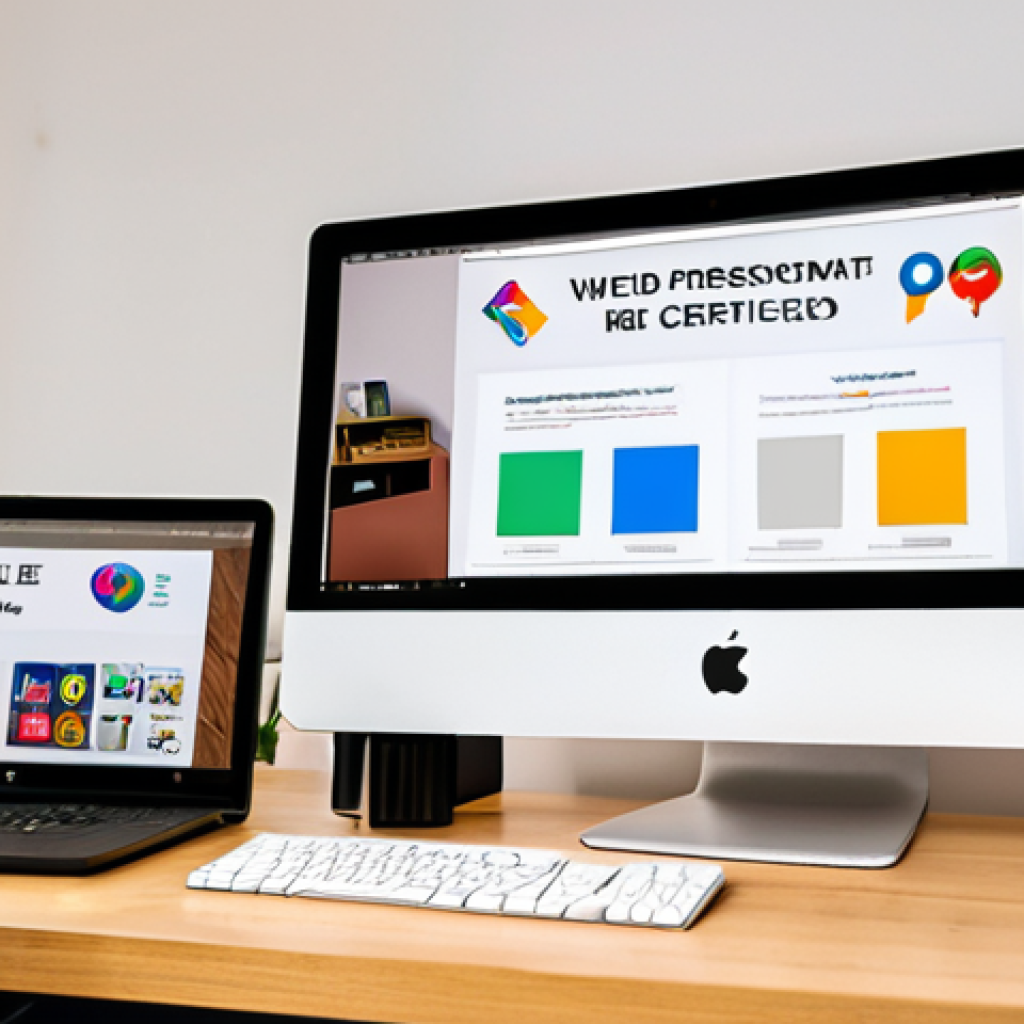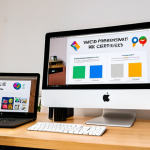Alright, here’s a blog-style intro about web design certificate salary comparisons:So, you’re eyeing a career in web design? Smart move! It’s a field bursting with creativity and demand, but let’s be real, navigating the certification landscape can feel like wading through alphabet soup.
From Google’s UX Design Professional Certificate to specialized coding bootcamps and even Adobe Certified Professional credentials, the options are vast.
I’ve noticed a lot of buzz lately about how these certifications translate to actual salary increases, and honestly, the range seems pretty wide. Having chatted with a few designers who’ve gone down different paths, I’m curious to see if some certs truly open doors to bigger paychecks faster than others.
Plus, with AI tools like Midjourney becoming more accessible, the demand for skilled and certified designers is expected to keep growing. Let’s get the facts straight.
Let’s dive in and get a clear picture of the salary potential of each web design certificate!
Alright, here’s a blog-style intro about web design certificate salary comparisons:So, you’re eyeing a career in web design? Smart move! It’s a field bursting with creativity and demand, but let’s be real, navigating the certification landscape can feel like wading through alphabet soup.
From Google’s UX Design Professional Certificate to specialized coding bootcamps and even Adobe Certified Professional credentials, the options are vast.
I’ve noticed a lot of buzz lately about how these certifications translate to actual salary increases, and honestly, the range seems pretty wide. Having chatted with a few designers who’ve gone down different paths, I’m curious to see if some certs truly open doors to bigger paychecks faster than others.
Plus, with AI tools like Midjourney becoming more accessible, the demand for skilled and certified designers is expected to keep growing. Let’s get the facts straight.
Decoding the Dollar Signs: Does Certification Really Matter?

It’s the million-dollar question, right? Does slapping a fancy certification badge on your LinkedIn profile actually translate into more moolah? From my experience, it’s not quite that simple.
A certificate *can* be a golden ticket, but it’s more about what you *do* with it. I’ve seen folks with impressive certs gathering dust because they lack practical skills or struggle to apply their knowledge to real-world projects.
On the flip side, I know self-taught designers who are absolutely killing it because they’re constantly learning, building a strong portfolio, and networking like crazy.
So, while a certificate can give you a leg up, it’s not a guaranteed path to riches. It’s more like a really good map – you still have to do the work to reach your destination.
My colleague, Sarah, who recently completed the Google UX Design Professional Certificate, put it perfectly: “The certificate opened doors for interviews, but it was my portfolio and ability to articulate my design process that sealed the deal.”
The “Show, Don’t Just Tell” Portfolio Effect
This is where the rubber meets the road. You can boast about being an Adobe Certified Professional, but if your portfolio looks like it was designed in 1998, you’re going to have a hard time convincing anyone you’re worth top dollar.
Employers want to see concrete examples of your skills. They want to see how you solve problems, how you approach design challenges, and how you bring ideas to life.
A strong portfolio demonstrates your ability to translate theoretical knowledge into practical application. Consider including case studies, user research findings, and iterations of your design process.
Highlight projects that showcase your understanding of user-centered design principles and your ability to create intuitive and engaging user experiences.
Networking Your Way to a Higher Salary
Don’t underestimate the power of human connection. Networking can be a game-changer when it comes to salary negotiations. Attending industry events, joining online communities, and connecting with other designers can provide invaluable insights into salary trends and negotiation strategies.
Talking to people who are already working in your field can give you a realistic understanding of what you’re worth and what you can expect to earn. Plus, networking can lead to job opportunities that you might not find through traditional job boards.
Remember, a recommendation from someone within the company can significantly boost your chances of getting hired and negotiating a higher salary.
Google’s UX Design Certificate: A Rising Star?
Lately, the Google UX Design Professional Certificate has been generating a lot of buzz, and for good reason. It’s a comprehensive program that covers the fundamentals of UX design, from user research and wireframing to prototyping and usability testing.
What sets it apart is its focus on practical skills and real-world projects. The course includes hands-on exercises and simulations that allow you to apply your knowledge and build a portfolio of work.
Plus, the Google brand name carries a lot of weight, which can be a significant advantage when applying for jobs.
Earning Potential and Career Trajectory
Let’s talk numbers. Entry-level UX designers with the Google certificate can expect to earn a competitive salary, especially in major metropolitan areas.
The exact amount will depend on factors such as experience, location, and company size. However, the Google certificate can give you a significant advantage in the job market and help you negotiate a higher starting salary.
As you gain experience and build your portfolio, your earning potential will continue to increase. Senior UX designers with several years of experience can command salaries well into the six-figure range.
Is it Worth the Investment? Considerations Before You Commit
Before you jump on the Google certificate bandwagon, it’s important to consider your individual circumstances and career goals. If you’re completely new to UX design, the certificate can be a great way to learn the fundamentals and build a foundation of knowledge.
However, if you already have some experience or a background in a related field, you might be able to get away with a more targeted course or bootcamp.
Also, consider your learning style and budget. The Google certificate is a significant time commitment, and it’s not free. Make sure you’re prepared to invest the time and money required to complete the program.
The Adobe Certified Professional: Mastering the Creative Suite
For those focused on the visual aspect of web design, the Adobe Certified Professional (ACP) designation can be invaluable. This certification demonstrates proficiency in Adobe’s Creative Suite, including Photoshop, Illustrator, and InDesign.
While not solely focused on web design, these tools are essential for creating visually appealing and engaging websites. The ACP certification validates your skills in using these tools effectively and efficiently, which can be a major selling point for employers.
Beyond the Basics: Specializing for Higher Pay
The web design world is constantly evolving, and staying ahead of the curve is essential for maximizing your earning potential. Consider specializing in a particular area of web design, such as front-end development, back-end development, UI/UX design, or e-commerce development.
Specializing allows you to develop in-depth knowledge and skills in a specific area, making you a more valuable and sought-after asset. This can translate into higher salaries and more job opportunities.
From Freelancer to Agency: Pathways to Advancement
The career path for web designers can vary widely. Some choose to work as freelancers, while others prefer the stability of working for an agency or corporation.
Each path offers its own unique advantages and disadvantages. Freelancing allows you to set your own hours and work on a variety of projects, but it also requires you to handle your own marketing and business administration.
Working for an agency or corporation provides more stability and benefits, but it may also involve less flexibility and creativity. Consider your personal preferences and career goals when choosing your career path.
Bootcamps: An Intense Dive into Coding and Design
Coding bootcamps offer an accelerated path to web development and design skills. These intensive programs condense months of learning into weeks, providing hands-on experience and practical knowledge.
While the cost can be significant, bootcamps often boast high job placement rates and can quickly equip you with the skills needed for an entry-level position.
However, be sure to research the bootcamp’s curriculum, instructors, and career support services to ensure it aligns with your goals.
Immediate Job Readiness
Bootcamps are designed to get you job-ready in a matter of weeks. The focus is on practical skills and real-world application, ensuring you can hit the ground running in your first role.
The accelerated pace and immersive environment can be incredibly effective for those who thrive in high-pressure situations.
Networking Opportunities and Career Services
Many bootcamps offer robust career services, including resume workshops, interview preparation, and networking events. These resources can be invaluable in helping you secure a job after graduation.
Additionally, the cohort-based structure of bootcamps provides a built-in network of peers who can offer support and collaboration throughout your career.
Negotiating Your Worth: Know Your Market Value
Regardless of your certifications or experience, negotiation is a critical skill for maximizing your salary. Research industry standards, understand your value, and be prepared to confidently articulate your worth to potential employers.
Don’t be afraid to negotiate for a higher salary, better benefits, or additional perks. Remember, the first offer is rarely the best offer.
Comparative Salary Snapshot
Here’s a quick look at estimated salary ranges based on certification and experience. Note that these are just averages, and actual salaries can vary widely:
| Certification/Experience Level | Estimated Annual Salary (USD) |
|---|---|
| Entry-Level Web Designer (No Certification) | $45,000 – $60,000 |
| Entry-Level Web Designer (Google UX Design Certificate) | $55,000 – $75,000 |
| Web Designer (Adobe Certified Professional) | $60,000 – $80,000 |
| Mid-Level Web Designer (3-5 Years Experience) | $75,000 – $100,000 |
| Senior Web Designer (5+ Years Experience) | $100,000+ |
Beyond the Base: Benefits and Perks to Consider
Don’t just focus on the base salary. Consider the entire compensation package, including benefits such as health insurance, paid time off, retirement plans, and stock options.
These benefits can add significant value to your overall compensation and should be factored into your negotiation strategy. Also, don’t be afraid to ask for perks such as professional development opportunities, remote work options, or a flexible work schedule.
Staying Current: Continuous Learning and Skill Development
The web design landscape is constantly changing, with new technologies and trends emerging all the time. To stay competitive and maximize your earning potential, it’s essential to commit to continuous learning and skill development.
This could involve taking online courses, attending workshops, reading industry publications, or participating in online communities.
The Value of Specializing in Emerging Technologies
As new technologies emerge, specialists in those areas become highly sought after. Consider focusing on areas like AI-assisted design, Web3 development, or advanced JavaScript frameworks.
Expertise in these cutting-edge areas can significantly increase your market value.
Building a Personal Brand: Showcasing Your Expertise
Establishing a strong personal brand can open doors to new opportunities and higher salaries. Share your knowledge through blog posts, webinars, or social media content.
Building a reputation as an expert in your field can attract potential employers and clients, increasing your earning potential.
In Conclusion
Navigating the web design career path involves a blend of formal education, practical skills, and strategic career moves. Certifications like the Google UX Design Professional Certificate and the Adobe Certified Professional can provide a competitive edge, but a strong portfolio, networking skills, and continuous learning are equally important. Remember to negotiate your worth and stay current with emerging technologies to maximize your earning potential.
Good to Know Information
1. Explore Free Resources: Platforms like Codecademy and freeCodeCamp offer valuable free courses in web design and development.
2. Attend Local Meetups: Check out Meetup.com for local web design and development events. Networking with other professionals can provide valuable insights and opportunities.
3. Follow Industry Influencers: Stay updated on the latest trends and technologies by following influential designers and developers on social media and blogs.
4. Contribute to Open Source Projects: Contributing to open-source projects can help you build your portfolio, gain experience, and network with other developers.
5. Leverage LinkedIn Learning: LinkedIn Learning offers a wide range of courses in web design, UX design, and front-end development. Many of these courses come with certificates upon completion.
Key Takeaways
Certifications can boost your salary, but practical skills are essential.
Networking and a strong portfolio are crucial for career advancement.
Continuous learning is necessary to stay competitive in the web design field.
Frequently Asked Questions (FAQ) 📖
Q: Does getting a web design certificate really boost my salary?
A: Okay, so here’s the thing – it’s not a guaranteed golden ticket, but it can definitely give you a leg up. Think of it like this: a solid certificate shows employers you’re serious about your craft and have a baseline level of competence.
I’ve seen some companies prioritize candidates with specific Adobe or Google certifications, especially for intermediate or senior roles. But honestly, the type of certificate matters, and how well you can apply those skills to real-world projects.
A fancy certificate won’t save you if your portfolio is weak.
Q: Which web design certificate offers the best ROI (Return on Investment) in terms of salary?
A: That’s the million-dollar question, right? It’s tricky because “best” is subjective and depends on your career goals. Generally, industry-recognized certificates from giants like Google (their UX Design Professional Certificate is pretty popular) or specialized certificates focused on in-demand skills like React or advanced JavaScript tend to hold more weight.
I’d also suggest looking into certificates that align with specific job descriptions you’re targeting. For example, if you want to work on e-commerce sites, a certificate in Shopify development might be a fantastic investment.
Don’t forget to factor in the certificate’s cost and time commitment when you’re calculating ROI!
Q: Besides salary, what are other benefits of getting a web design certificate?
A: Honestly, the salary boost is just the tip of the iceberg! For me, a big benefit was building confidence. Learning new skills and getting validation through a certificate gave me a much-needed boost when I was starting out.
It also opened doors to networking opportunities. I met some incredible mentors and peers through online courses and workshops associated with my certificate.
Plus, it signals to potential clients (if you’re freelancing) that you’re committed to professional development and staying up-to-date with the latest design trends.
So, it’s not just about the money – it’s about the whole package.
📚 References
Wikipedia Encyclopedia
구글 검색 결과
구글 검색 결과
구글 검색 결과
구글 검색 결과
구글 검색 결과



